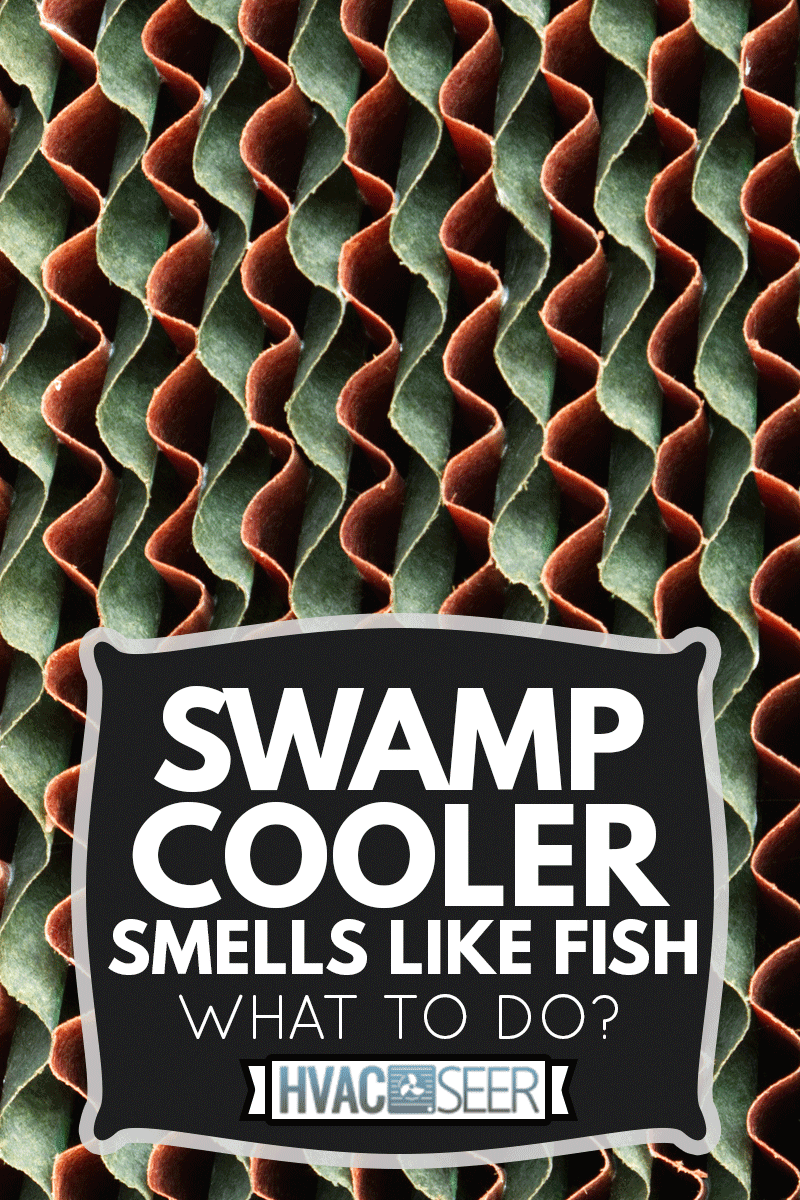There is nothing better than the fresh, cool air that comes from a swamp cooler, but have you noticed a boggy or dubious odor that makes your home smell like the local seafood market? We’ve done a comprehensive search of expert advice to help you understand - and solve the problem - of why your swamp cooler smells fishy.
Reasons your swamp cooler smells fishy:
- There is bacteria, mold, or algae growing somewhere in the cooler.
- There is a foul odor venting near your air intake.
- The public water supply is disinfected with Chloramine.
- There is an overheating electrical component.
- The plumbing could be deteriorating.
Swamp coolers may make us cooler, but we don’t want our home to smell like a bog! There are a few reasons why your swamp cooler might be blowing a fetid odor into your house. We’ve covered how to deal with each one below. Simply continue reading to find the answers on how to turn your home from fishy to fresh!

How a Swamp Cooler works
A swamp cooler - or evaporative cooler - functions by the process of evaporative cooling. It’s a simple and effective process where warm air is blown through, or over, water. The water absorbs the heat and then becomes gaseous - that’s evaporation. You experience it every time you sweat, and the sweat cools your body. The process was even used by Egyptians who hung wet cloth or reeds in a breezy window or fanned someone across a jug of water.
In modern times, we don’t have to rely on a hand-held fan or a breeze. We have replaced that with a water pump that keeps fiber pads moist, then a simple electric fan blows air through the pads. The problem of odor comes from the associated humidity. Mold, bacteria, and algae spores arrive via air currents and thrive in this damp environment.
How to Find Fishy Odors
Visibly inspect your unit - inside and outside the house - and look for:
- discolored or stained areas
- floating debris
- odorous vents from your home or nearby buildings
- smells originating anywhere around your unit - check for several feet
Now, let's look at each potential problem that could arise to cause odor from these conditions and how to solve it!
1. Fishy Odor from Bacteria or Mold
The most common reason for a fishy odor is usually bacteria or mold build-up and microscopic algae. All of these come from spores in the air that find their way on air currents into the unit. Cleaning the unit will usually remove the fishy odor resulting from the growth of these spores.
Clean your Swamp Cooler
- Carefully remove the outside panels.
- Take out the fiber or synthetic pads.
- Drain the water from your overflow pan.
- Brush out any loose debris and visible dirt.
- Use soap and water to clean the overflow pan (that pan at the bottom) including the drain plug, and anything you can safely clean - do not allow the motor, fan belt, or mechanical parts to become wet.
- Rinse the pan thoroughly, then fill it with white vinegar and let it sit for at least an hour - you may need to cycle the vinegar through the system to clean inside the water distributor tubes.
- Drain the vinegar and rinse thoroughly again with clean water. Cycle water through the tubes if you cycled vinegar in the previous step.
- Replace the pads with new pads if needed.
- Reassemble the unit.
2. Fishy odor due to foul air intake
The second reason for a fishy odor could be the outside air that is being drawn into your cooler. If your unit is scrupulously clean, walk outside and check for any vents around your cooler. Look at your own and neighboring buildings. It may take a few days to determine where the odor is emanating. A fishy smell could be coming from a far-away vent that only runs once a day, for instance.
Redirect or Relocate vent
Attempt to relocate or redirect the offending vent. You may need a contractor to help you, or it may be as simple as adding an extension to redirect the foul air away from your air intake.
Install a carbon filter
If redirecting or relocating a vent are not options, try filtering out incoming odors. Carbon filters can stop odors from entering your home. This type of simple carbon filter can be cut-to-fit and installed on the air-intake side of your cooler. See carbon filters on Amazon.
3. Chloramine or organic materials in your water supply
Unfortunately, the blessing of potable water is also a possible source of fishy odors. Public water supplies are often treated for safety using a combination of chlorine and ammonia. If you know the fishy smell is not coming from your unit, see if your tap water actually smells fishy.
Additionally, corroded plumbing can allow natural metals like barium or cadmium into your pipes and cause a fishy smell in your water. You may need to get an expert opinion and/or test your water.
Install a water filter
This can be difficult or simple, depending on how your cooler receives water. If you simply add water to a reservoir, you will need to switch to distilled water. However, if your cooler is hooked directly to your water supply, you can install an inline filter.

Notice in the picture that you can configure the filter to supply water only to your cooler.
If you have an assembly such as the picture below, you can install an inline filter on the tubing. You may be able to do this yourself with a plumbing book borrowed from the library. You can modify these types of water intake systems to accept a filter. See this garden hose hook-up on Amazon.
4. Fishy odor from overheating electrical component
Yes, the fishy odor from your cooler might actually be an electrical problem. If you have eliminated every other possibility, there may be a problem with a nearby electrical panel or an electrial component of the unit. Overheating electrical can actually give off a fishy odor. If it’s near your air intake, and you only smell it when the cooler is running, this could be the source of your fishy odor.
Infrared Camera Detection
If you suspect an overheating electrical component, carefully smell - do not touch - any electrical that is near your unit’s air intake. If you smell fish, and it’s not from any other source, it could be an electrical component. An overheating electrical panel installed near the air intake can be the source of a fishy odor.
You will need a qualified electrician who can use an infrared camera to detect exactly where the overheating is taking place so that it can be properly repaired.

If you are experienced in electrical work and suspect an electrical panel issue, carefully open the panel door and look - do not touch - for any burnt or discolored electrical components. If you smell a fishy odor, call an electrician right away. If you suspect an imminent fire, leave the immediate area and call the fire department - 911 - they will advise you over the phone. Electrical fires are very dangerous, do not attempt to make repairs unless you are a qualified electrician.
How Often Should Swamp Cooler Pads Be Replaced?
Swamp cooler pads are made from either natural Aspen tree fiber or synthetic fibers. Some are even made from cardboard fiber. If you have an Aspen pad, you need to change it at least once a year. If you are using a synthetic fiber pad, you may only need to change it once every three years. Most synthetic or cardboard fiber pads manufacturers will give you clear instructions on how often to replace their products. A good rule of thumb is if your pad looks dirty, it probably needs to be replaced.
How Can You Make Swamp Cooler Water Smell Better?
Since swamp cooler odors are usually caused by water, the best and cheapest thing you can do to make the water smell better is to change the water in the overflow pan regularly. Turn off your unit, then empty and replace the water. If you do this weekly, you should have almost no problem with odor.
You can also add a few capfuls of hydrogen peroxide to the water to prevent anything from growing. Bacteria, mold, algae, and any other spore that enters your cooler won’t like the acidity of the water when hydrogen peroxide is added, and they won’t find it easy to grow. An ounce or a capful of prevention is worth a pound of cure.
Can You Put Essential Oil In A Swamp Cooler?
If you’ve ever used essential oils in a bottle with a rubber dropper, you may have noticed the rubber disintegrates over time. This is because essential oils naturally contain organic solvents, and they can soften or dissolve some rubbers or plastics. This could potentially damage any parts of your cooler made from these products. However, a few drops every now and then in your swamp cooler pan to disinfect or kill bacteria is relatively safe; use the rule of everything in moderation!
Can You Put Fabric Softener In A Swamp Cooler?
Many websites recommend putting fabric softener in your swamp cooler to eliminate or mask smells, but from a health standpoint, synthetic fragrances contain Endocrine Disrupting Chemicals or EDCs. Your home may already contain many EDCs, so it’s not a great idea to add them to the air you are breathing - that’s a proven route for chemicals to enter your bloodstream.
The Natural Resource Defense Council (NRDC) warns the public to avoid adding synthetic fragrances to your home, especially air-fresheners. If your swamp cooler smells funny, try adding a few capfuls of hydrogen peroxide to freshen the water if you don’t have time to do a thorough cleaning.
Troubleshooting Odor for a Swamp Cooler On the Roof
This is a special problem because you can’t easily access the roof to inspect or solve problems that may be causing a fishy odor. Additionally, you may have ducting that could be contaminated with spores that are growing and making your house smell like an aquarium. One option is to speak to the HVAC company that does your maintenance and asking for their advice. If they want to charge you for a service call before being helpful, telephone someone else.
There are also several products that can be used to keep ducts from causing a fishy smell in the house. A good, non-chemical option is an ionizing air cleaner that kills spores in the air.
This ionizing air cleaner can be installed inside an air duct to keep the air fresh. See it on Amazon, click here.
In Closing
Fishy odors from your swamp cooler don’t always have the same source; determine the problem and apply one of the solutions above. Inspections, regular cleaning, and changing the pads are key factors to keep away fishy odors. You should use fabric softeners or essential oils added to the water sparingly to avoid possible health risks or damage to your cooler. A little hydrogen peroxide can prevent problems before they start. Never attempt electrical repairs on your own; call a qualified professional. If you follow these steps, you can look forward to a brighter - and fresher smelling - future!
For more information about swamp coolers, read this informative article, "How Often Should An Evaporative Cooler Dump Water?"
If you are considering a new HVAC system, read this excellent article about "6 Types Of Air Conditioners" to find out exactly which one is best for your needs.



